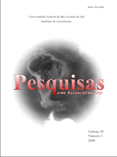Estimate of longshore sediments transport from waves data to the Rio Grande do Sul coast
DOI:
https://doi.org/10.22456/1807-9806.20272Keywords:
Rio Grande do Sul coast, littoral drift, coastal erosian.Abstract
Waves data and a simple mathematical model was used to determine the longshore sediments transport at the Rio Grande do Sul coast. The model was developed by the application of the Energy Flow Method (U.S. Army, 1984), to estimate quantitatively the littoral drift potential for different segments of the coast. The coast was divided in segments or straight lines, which has the same orientation. The coefficient of proportionality between the wave energy and the sediment transport was obtained using beach profile surveys and sediment grain size. The largest drift taxes were of the order of -2.900.000 m3/year and -2.600.000 m3/year for NE, along of the Hermenegildo beach and Between Cassino and Solidão Beach, respectively. reasonable agreement exists between coastal erosion observations in previous studies and the result obtained by this model, which suggests that a predictive capability has been established.



